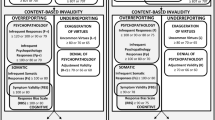Abstract
Two studies examined whether the middle response option in graphic rating scales indicates a moderate standing on a trait/item, or rather a “dumping ground” for unsure or non-applicable (N/A) responses. Study One identified middle response-option dysfunction. Study Two indicated that respondents use the middle response option as an N/A proxy, even under implicit ‘skip if you do not know’ instructional sets. Although middle response category ‘misuse’ did not adversely affect reliability and validity in these studies, it is recommended that assessment developers (especially in on-line administration contexts) regularly include an N/A response option when administering graphic rating scales.


Similar content being viewed by others
Notes
This is in fact the case looking at the correlations of middle category endorsement (across 300 items) with Big 5 scale scores for Study One’s 21,588 participants (r neur = .11, r con = −.20, r agree = −.11, r open = −.24, r ext = −.14, all p’s < .0001).
References
Andrich, D. (1978). A rating formulation for ordered response categories. Psychometrika, 43, 561–574.
Andrich, D. (2004). Understanding resistance to the data-model relationship in Rasch’s paradigm: A reflection for the next generation. In E. V. Smith Jr. & R. M. Smith (Eds.), Introduction to Rasch Measurement (pp. 167–200). Maple Grove, MN: JAM Press.
Costa, P. T. Jr., & McCrae, R. R. (1992). Revised NEO personality inventory (NEO PI-RTM) and NEO five-factor inventory (NEO-FFI) professional manual. Odessa, FL: Psychological Assessment Resources.
DuBois, B., & Burns, J. A. (1975). An analysis of the meaning of the question mark response category in attitude scales. Educational & Psychological Measurement, 35, 869–884.
Goldberg, L. R. (1999). A broad-bandwidth, public-domain, personality inventory measuring the lower-level facets of several five-factor models. In I. Mervielde, I. Deary, F. De Fruyt, & F. Ostendorf (Eds.), Personality psychology in Europe (Vol. 7, pp. 7–28). Tilburg, The Netherlands: Tilburg University Press.
Hanisch, K. A. (1992). The job descriptive index revisited: Questions about the question mark. Journal of Applied Psychology, 77, 377–382.
Hofacker, C. F. (1984). Categorical judgment scaling with ordinal assumptions. Multivariate Behavioral Research, 19, 91–106.
Johnson, J. A. (2005). Ascertaining the validity of individual protocols from Web-based personality inventories. Journal of Research in Personality, 39, 103–129.
Likert, R. (1932). A technique for the measurement of attitudes. Archives of Psychology, 22(140), 5–55.
McFadden, L. S., & Krug, S. E. (1984). Psychometric function of the “neutral” response option in clinical personality scales. Multivariate Experimental Clinical Research, 7, 25–33.
Preston, C. C., & Colman, A. M. (2000). Optimal number of response categories in rating scales; reliability, validity, discriminating power, and respondent preferences. Acta Psychologica, 104, 1–15.
Schriesheim, C., & Schriesheim, J. (1974). Development and empirical verification of new response categories to increase the validity of multiple response alternative questionnaires. Educational & Psychological Measurement, 34, 877–884.
Shaw, M. E., & Wright, J. M. (1967). Scales for the Measurement of Attitudes. New York: McGraw-Hill.
Smith, P. C., Kendall, L. M., & Hulin, C. L. (1969). The measurement of satisfaction in work and retirement: A strategy for the study of attitudes. Skokie, IL: Rand-McNally.
Steiger, J. H. (1980). Tests for comparing elements of a correlation matrix. Psychological Bulletin, 87, 245–251.
Stevens, S. S. (1946). On the theory of scales of measurement. Science, 103, 677–680.
Stone, M. H. (2004). Substantive scale construction. In E. V. Smith Jr. & R. M. Smith (Eds.), Introduction to Rasch measurement (pp. 201–225). Maple Grove, MN: JAM Press.
Author information
Authors and Affiliations
Corresponding author
Rights and permissions
About this article
Cite this article
Kulas, J.T., Stachowski, A.A. & Haynes, B.A. Middle Response Functioning in Likert-responses to Personality Items. J Bus Psychol 22, 251–259 (2008). https://doi.org/10.1007/s10869-008-9064-2
Published:
Issue Date:
DOI: https://doi.org/10.1007/s10869-008-9064-2




